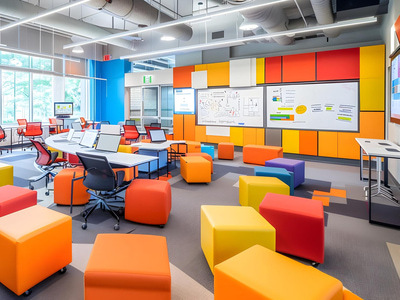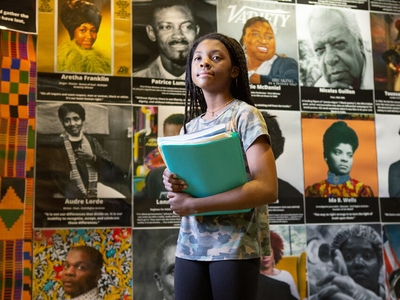New Designs for School
Seven Strategies for Supporting Student Self-Sufficiency
Topics

We’ve all had the experience of truly purposeful, authentic learning and know how valuable it is. Educators are taking the best of what we know about learning, student support, effective instruction, and interpersonal skill-building to completely reimagine schools so that students experience that kind of purposeful learning all day, every day.
Increasing student autonomy does not mean that educators relinquish all control or abdicate responsibility for classroom management. So what does it look like?
Research from the American Psychological Association (APA) points to an alarming increase in feelings of frustration and letdown levels in both students and the educators who guide them in attempting to develop autonomous, independent learners. Much of this academic dissonance, according to the APA research, stems from accountability measures designed to ensure students meet rigorous state standards across schools. What, precisely, defines student autonomy, and how does one account for it? In addition, how do we best support students to overcome obstacles and achieve classroom success?
As Dimitrios Thanasoulas describes, student autonomy is defined as creating in classrooms a “shift of responsibility from teachers to learners.” Yet increasing student autonomy does not mean that educators should relinquish all classroom control or wantonly toss a white flag to abdicate responsibility for classroom management. Instead, Thanasoulas refers to teachers creating “sufficient conditions for the development of learner autonomy, and [accounting for] many more factors such as learner needs, motivation, learning strategies, and [self-]awareness.”
How can we, as passionate educators, best support students in their quest to become more autonomous, independent learners? Here are seven strategies you may choose to infuse.
Student Learning Logs
First, consider the use of student learning logs in your daily routine. Educators could prepare marked marble notebooks to challenge students to consider at the outset of a unit, “What do I already know about this topic?” and, “What would I like to learn?” Students could then record what they are learning as a unit progresses; this not only provides insight into students’ thinking for educators, but it also helps students account for their own learning. Upon unit completion, students could then put pen to paper to summarize their overall learning experiences. Thought-provoking, follow-up questions such as, “What was I readily able to grasp, and why?” and, “What was most challenging, and why?” provide valuable insights (and data!) for educators to consider for reflection, progress monitoring, and fine-tuning future lessons.
Responsive Rubrics
How fatigued are you from developing rubrics for your interactive classroom activities? How about permitting your students to take the rubric reins? Consider allowing the class to create responsive rubrics. Provide the class with copies of your rubric, and then offer an opportunity for students to discuss in pairs or small groups what each level of performance represents. Rather than force-feed arcane acronyms, let students develop the language that makes sense for them to fathom how to accomplish tasks and account for their progress. Then provide blank templates for students to re-write the original rubric in their own words. Responsive rubrics should spark motivation as students themselves conceive of and delineate their own measures of academic magnitude and standards for success.
Anchor Papers
Anchor papers provide lucid examples of work generally meeting the performance at each level of a rubric. These singular sample selections could be useful for students to determine how their own work may compare. Rather than informing students how each anchor paper was graded, have your students discuss in pairs, triads, or small groups how they believe a paper measures against the established rubric. This activity could help generate some strong intellectual discourse as students reflect on their own work and consider what steps they, themselves, may need to take to ascend.
Stop, Go, or I Don’t Know (YET)
Next, provide students red, green, and yellow markers to depict, “Stop, Go, or I Don’t Know (YET).” In this activity, students highlight their work indicating their levels of comfort, providing a visual tracking of their current progress and depth of understanding. Green clearly means go, so students could indicate that they feel confident about their relevant topic knowledge and could readily move on to the next section or topic. Red symbolizes stop, signaling that the teacher needs to approach, re-teach, or provide some other scaffolding to untie knowledge knots. Yellow highlighter markings signify that students somewhat fathom this material, but may not be entirely confident in their understanding. Remember to emphasize to students the power of YET, that both red and yellow highlighted sections signify that, although students may not understand this material entirely yet, they will with time and sustained effort.
You may want to consider turning “Stop, Go, or I Don’t Know (YET)” into an interactive classroom activity. Students could seek out classmates for clarification; just ensure that the environment is one of trust and mutual respect so no teasing or bullying of any kind results. Throughout this activity, delving into honesty helps students consider their knowledge, comfort levels, and material proficiency.
Scholarly Reflection
Just as the protagonist had needed space and time to ponder the essence of her existence in the Disney classic, “Mulan,” children also need precious moments to reflect upon academics. Thus, you may want to consider providing opportunities for scholarly reflection. As a classroom teacher, I had provided paper with the image of a mirror for students to “look inside” and scribe, “I appreciated the lesson because...” and, “I will apply this to my life by...” You could also provide pensive moments with sentence starters such as, “I could have better fathomed this material if...” or, “One action I will take to better fathom this material is...” to promote higher-level, metacognitive musings.
Student-Centered Conferences
Student-centered conferences empower children to self-reflect and forge their own academic paths. As opposed to teacher-led conferences which tend to be partial, students are instead asked to consider their learning with open-ended questions such as, “What made you decide to write this?” “What are you thinking?” “What are you learning from your work?” By guiding students to self-reflect and discover on their own instead of imparting judgment on what may be right or wrong, students can self-actualize, form their own opinions, and ask for support sans apprehension.
Linear Representations
Finally, linear representations delineate actual achievement and empower students to account for and track their own progress. With linear representations, students could chart their own courses toward success and revise goals to meet or exceed expected learning outcomes. Educators may also choose to use linear representations to spark thought-provoking academic discourse.
While conferencing with students, pay particular attention to the goals they have set for themselves, and provide ample praise throughout the learning process. If students succeed, provide opportunities for reflection; for instance, ask how their achievement was accomplished. What measurable steps did the student take? We want students to consider their choices, unlock their inner passions, and strive for success, even when no one is around to reinforce positive habits. Ultimately, with guidance, students should be empowered to face potential failures with aplomb and continue to believe that they can always achieve.
Photo at top by rawpixel.




